
by Editor | Sep 25, 2014 | News, Slider
 27th September 2014
27th September 2014
Showtime Productions presents…
A wonderful concert by well known singers from Singing for Pleasure with specially invited guest performers.
An exciting programme of favourite songs from West End & Broadway Shows and popular classical songs.
One performance only!
at 2.30pm – Tickets £10
Includes delicious cream cakes and refreshments. Discounts for groups, children and senior citizens.
Songs from my Fair Lady inc; With a little bit of luck, Get me to the church on time, I could have danced all night. Andrew LLoyd Webber songs inc; music of the night. And a huge variety inc; Who wants to be a millionaire, No business like show Business, over 30 songs for your enjoyment!
Fundraising on the day supporting the Martlets Hospice
Bishop Hannington Church, Nevill Avenue, Hove
Box Office: 01273 555089 [email protected] • www.singingforpleasure.com Sponsored by: Streamline Taxis tel. 01273 20 20 20 / 747474

by Editor | Sep 17, 2012 | Brighton, Slider
 [contentbox headline=”Brighton and Hove Seafront” type=”info”]Brighton and Hove beaches stretch for about 7 miles, from Hove Lagoon in the West to Rottingdean in the East. The seafront has bars, restaurants, nightclubs and amusement arcades, principally between the piers. Being less than an hour from London by train has made the city a popular destination, especially with big party groups. Brighton beach has a nudist area (by Kemptown near the easterly edge of the promenade). Brighton’s beach, which is a shingle beach up to the mean low tide mark, has been awarded a blue flag. The Monarch’s Way long-distance footpath heads west along the seafront above the beach.
[contentbox headline=”Brighton and Hove Seafront” type=”info”]Brighton and Hove beaches stretch for about 7 miles, from Hove Lagoon in the West to Rottingdean in the East. The seafront has bars, restaurants, nightclubs and amusement arcades, principally between the piers. Being less than an hour from London by train has made the city a popular destination, especially with big party groups. Brighton beach has a nudist area (by Kemptown near the easterly edge of the promenade). Brighton’s beach, which is a shingle beach up to the mean low tide mark, has been awarded a blue flag. The Monarch’s Way long-distance footpath heads west along the seafront above the beach.
Since the 1978 demolition of the open-air lido at Black Rock, the most easterly part of Brighton’s seafront, the area has been developed and now features one of Europe’s largest marinas. However, the site of the pool itself remains empty except for a skate park and graffiti wall, and further development is planned including a high-rise hotel which has aroused debate, mirroring proposals for the King Alfred leisure centre in Hove, which were pulled in 2008. In addition, part of the eastern side of the beach has been redeveloped into a sports complex, which has courts for anything from beach volleyball to ultimate Frisbee, and opened to the public in March 2007.[/contentbox]
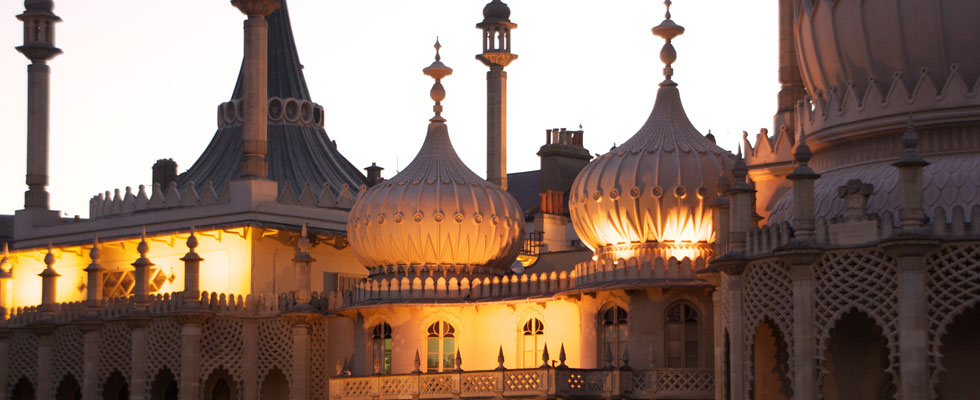
by Editor | Sep 15, 2012 | Brighton, Slider
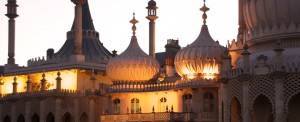 [contentbox headline=”The Royal Pavillion” type=”info”]The Royal Pavilion is a former royal residence located in Brighton UK. It was built in three campaigns, beginning in 1787, as a seaside retreat for George, Prince of Wales, from 1811 Prince Regent. It is often referred to as the Brighton Pavilion. It is built in the Indo-Saracenic style prevalent in India for most of the 19th century, with the most extravagant chinoiserie interiors ever executed in the British Isles.
[contentbox headline=”The Royal Pavillion” type=”info”]The Royal Pavilion is a former royal residence located in Brighton UK. It was built in three campaigns, beginning in 1787, as a seaside retreat for George, Prince of Wales, from 1811 Prince Regent. It is often referred to as the Brighton Pavilion. It is built in the Indo-Saracenic style prevalent in India for most of the 19th century, with the most extravagant chinoiserie interiors ever executed in the British Isles.
The Prince of Wales, who later became King George IV, first visited Brighton in 1783, at the age of 21. The seaside town had become fashionable through the residence of George’s uncle, the Prince Henry, Duke of Cumberland, whose tastes for cuisine, gaming, the theatre and fast living the young prince shared, and with whom he lodged in Brighton at Grove House. In addition, his physician advised him that the seawater would be beneficial for his gout. In 1786, under a financial cloud that had been examined in Parliament for the extravagances incurred in building Carlton House, London, he rented a modest erstwhile farmhouse facing the Steine, a grassy area of Brighton used as a promenade by visitors. Being remote from the Royal Court in London, the Pavilion was also a discreet location for the Prince to enjoy liaisons with his long-time companion, Mrs Fitzherbert. The Prince had wished to marry her, and did so in secrecy, as her Roman Catholicism ruled out marriage under the Royal Marriages Act.
In 1787 the designer of Carlton House, Henry Holland, was employed to enlarge the existing building, which became one wing of the Marine Pavilion, flanking a central rotunda, which contained only three main rooms, a breakfast room, dining room and library, fitted out in Holland’s French-influenced neoclassical style, with decorative paintings by Biagio Rebecca. In 1801-02 the Pavilion was enlarged with a new dining room and conservatory, to designs of Peter Frederick Robinson, in Holland’s office. The Prince also purchased land surrounding the property, on which a grand riding school and stables were built in an Indian style in 1803-08, to designs by William Porden that dwarfed the Marine Pavilion, in providing stabling for sixty horses.[1]
Between 1815 and 1822 the designer John Nash redesigned and greatly extended the Pavilion, and it is the work of Nash which can be seen today. The palace looks rather striking in the middle of Brighton, having a very Indian appearance on the outside. However, the fanciful interior design, primarily by Frederick Crace and the little-known decorative painter Robert Jones, is heavily influenced by both Chinese and Indian fashion (with Mughal and Islamic architectural elements). It is a prime example of the exoticism that was an alternative to more classicising mainstream taste in the Regency style.
[/contentbox]
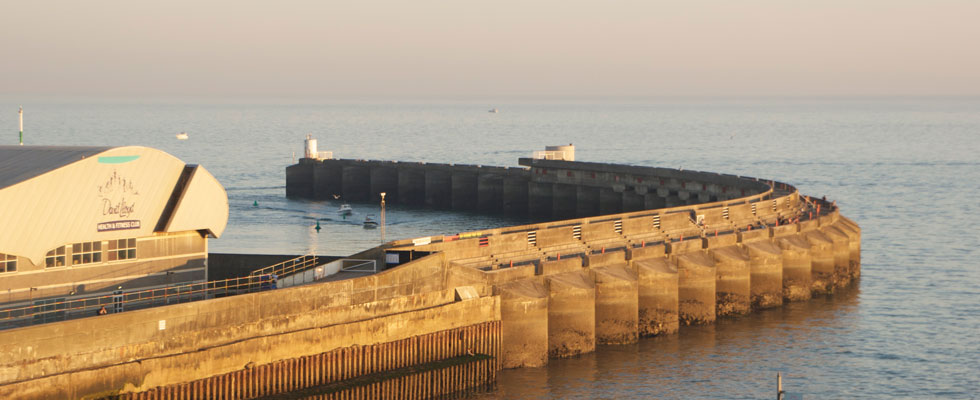
by Editor | Sep 15, 2012 | Brighton, Slider
 [contentbox headline=”Your headline” type=”info”]Brighton Marina is an artificial marina situated in Brighton, England. The construction of the marina itself took place between 1971 and 1979, although developments within it have continued ever since. The marina covers an area of approximately 127 acres (0.51 km2). It is owned and managed by Premier Marinas.
[contentbox headline=”Your headline” type=”info”]Brighton Marina is an artificial marina situated in Brighton, England. The construction of the marina itself took place between 1971 and 1979, although developments within it have continued ever since. The marina covers an area of approximately 127 acres (0.51 km2). It is owned and managed by Premier Marinas.
The land within the marina has been developed in several stages and now accommodates a large Asda supermarket and two groups of boutique shops, restaurants and bars, plus a hotel, a bowling alley, a health club, a casino, and a multiplex cinema with a multi-storey car-park built over and around it. On the east side of the marina there are several gated communities consisting of townhouses and apartments, some of which come with their own moorings, alongside public moorings and facilities for boats and their users, ranging from boat sales and service companies through to a floating launderette at the main moorings. Both harbour arms are popular locations for local fishermen; the east breakwater is often packed to capacity during summer weekends, and there are regular sightseeing and fishing boat trips from the marina.
A SeaJet service ran from the Marina to Dieppe in France between 1979 and 1980. Two Boeing Jetfoils were used, with three “flights” per day. The service suffered from poor reliability of the Jetfoils in the early stages, was restricted due to mid-channel wave height, and suffered during the French fishermen’s blockade of channel ports.
In 1992 there was a trial of summer-season passenger services to Fécamp, France, using a small catamaran ferry.
Immediately to the west of the marina is Black Rock, wasteground which was once a lido and is to be redeveloped into an arena.
Yacht sailing, powerboating, and dinghy sailing training and charter is offered by a number of operators within Brighton Marina.
Ongoing developments
Work was due to begin in spring 2007 on a new district of the marina to contain 853 new apartments, cafés, bars and restaurants. The development was planned for the south-western part of the marina and would partly sit on stilts over the sea. The centrepiece building was to be a skyscraper dubbed The Roaring Forties which would stand at 40 storeys tall and include a public viewing platform on the top floor. Two new pedestrian bridges were to be included in the scheme, one retractable to link the marina arms and the second to link the western beach with the new scheme. The developers are local firm Brunswick, and the architects are Wilkinson Eyre, noted for Gateshead Millennium Bridge. CABE have highlighted the development as one of four national developments demonstrating best practice in design and planning. No significant building work has started and the whole project has now been put on hold in view of the current financial climate.
A planning application to redevelop much of the west side of the marina was submitted in October 2007. The plans include several tall apartment blocks (the tallest would be Marina Point which would be 28 storeys high and Quayside which was to be 16 storeys), various new retail provisions including small shops, a new central square (where the current roundabout stands) and an “eco park”, connected to the Undercliff Walk. The supermarket would be demolished and rebuilt to a larger size with car parking underground and apartments above, freeing up the considerable space presently used for its open-air car park, allowing for further development. The petrol station and McDonalds would also be demolished and rebuilt under this scheme. Around five new apartment blocks would be added to the marina in total. The developers are Explore Living, a division of Laing O’Rourke, and the architects are Allies and Morrison. Planning permission for this scheme was refused on 12 December 2008 when the six Conservative and three Green members of the planning committee voted against it, with only the three Labour members voting in favour.
There has been considerable local opposition to both the above developments, which have been accused of being inappropriate, too dense, damaging to the Brighton skyline and to cliff and sea views, and in breach of the provision of the Brighton Marina Act 1968 that no building should exceed cliff height (approximately seven storeys). The main campaigning organisation is save brighton which is coordinating opposition from individual residents, residents’ organisations and amenity groups. The campaign was launched in November 2007. The founder of save brighton, Brian Simpson, has called for the “gross over development of Brighton Marina” to be stopped.
[/contentbox]
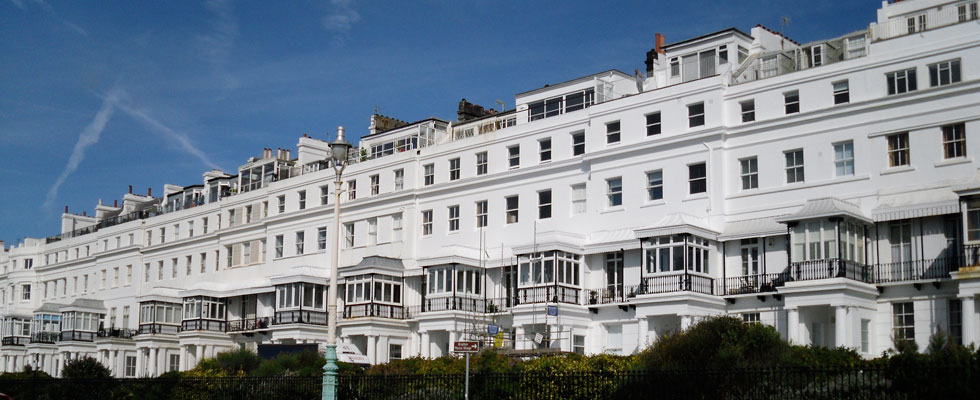
by Editor | Sep 15, 2012 | Brighton, Slider
 [contentbox headline=”Regency Brighton” type=”info”]
[contentbox headline=”Regency Brighton” type=”info”]
In the Domesday Book, Brighton was called Bristelmestune and a rent of 4,000 herring was established. In June 1514 Brighthelmstone was burnt to the ground by French raiders during a war between England and France. Only part of the St Nicholas Church and the street pattern of the area now known as “The Lanes” survived. The first drawing of Brighthelmstone was made in 1545 and depicts what is believed to be the raid of 1514. During the 1740s and 1750s, Dr Richard Russell of Lewes began prescribing seawater at Brighton.
From 1780, development of the Georgian terraces had started and the fishing village became the fashionable resort of Brighton. Growth of the town was further encouraged by the patronage of the Prince Regent (later King George IV) after his first visit in 1783. He spent much of his leisure time in the town and constructed the Royal Pavilion during the early part of his Regency. Although contracted forms of the name are attested since the 15th Century, it was not until this period that the modern form of the name came into common use.
The arrival of the London and Brighton Railway in 1841 brought Brighton within the reach of day-trippers from London and population growth from around 7,000 in 1801 to over 120,000 by 1901. The Victorian era saw the building of many major attractions including the Grand Hotel (1864), the West Pier (1866) and the Palace Pier (1899). Prior to either of these structures the famous Chain Pier was built, to the designs of Captain Samuel Brown. It lasted from 1823 to 1896, and featured in paintings by both Turner and Constable.
After boundary changes between 1873 and 1952, the land area of Brighton increased from 1,640 acres (7 km2) in 1854 to 14,347 acres (58 km2) in 1952. New housing estates were established in the acquired areas including Moulsecoomb, Bevendean, Coldean and Whitehawk. The major expansion of 1928 also incorporated the villages of Patcham, Ovingdean and Rottingdean, and much council housing was built in parts of Woodingdean after the Second World War.
More recently, gentrification of much of Brighton has seen a return of the fashionable image which characterised the growth of the Regency period. Recent housing in the North Laine, for instance, has been designed in keeping with the area.
In 1997 Brighton and Hove were joined to form the unitary authority of Brighton and Hove, which was granted city status by Queen Elizabeth II as part of the millennium celebrations in 2000.
Brighton is sometimes referred to as London-by-the-sea[/contentbox]
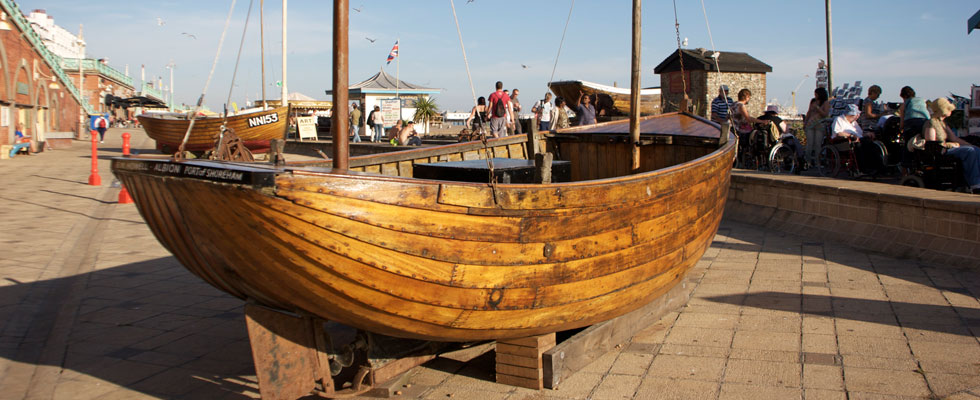
by Editor | Sep 15, 2012 | Brighton, Slider
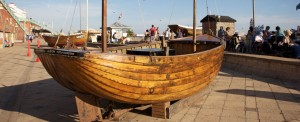 [contentbox headline=”Brighton Fishing Museum” type=”info”]Come take a journey with us into the rich history of Brighton’s Fishing Community. Discover a Brighton of the past: a bustling little fishing village on the south coast which was transformed into a fashionable seaside resort.
[contentbox headline=”Brighton Fishing Museum” type=”info”]Come take a journey with us into the rich history of Brighton’s Fishing Community. Discover a Brighton of the past: a bustling little fishing village on the south coast which was transformed into a fashionable seaside resort.
Brighton Fishing Museum traces the unique story of the fishing community in Brighton, captured in a wealth of film, photography, paintings and memorabilia of Brighton seafront life.
Let us guide you through the Brighthelmstone of the 1700s, when patients were first prescribed the seawater at Brighton for its medicinal benefits. You’ll discover how Brighton soon developed into a fashionable resort town, a retreat for the rich, following the patronage of the Prince Regent – all with mixed reception from Brighton’s fishing community at the time.
By the mid 1800s, with the arrival of the railway, Brighton had become a haven for day-trippers. Discover how many of the fishermen began scrubbing down their punts each day after fishing and turn them into pleasure boats. Fishermen became boatmen, showmen of the sea and the water a funfair.
With the arrival of the piers, you’ll see how Brighton became the town we know today.
Brighton Fishing Museum offers a truly intriguing look at the history of this famous town and it’s community. You’ll find hundreds of pictures and artefacts and if that wasn’t enough, we’ve managed to squeeze in a 27 foot clinker built punt boat – the traditional Sussex fishing boat – as the museum’s centre piece.
Go to the Brighton Museum Website for lots more info.
[/contentbox]

by Editor | Sep 15, 2012 | Brighton, Slider
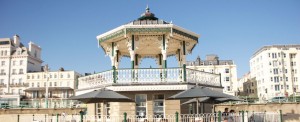 [contentbox headline=”Brighton Bandstand” type=”info”]
[contentbox headline=”Brighton Bandstand” type=”info”]
Beautiful and truly unique, Brighton Bandstand is located on Brighton’s vibrant seafront. It was restored to its original specification and reopened in 2009. The bandstand is now available as a venue for weddings and ceremonies. The ornate architecture is magnificently detailed offering the perfect choice for couples wanting an elegant beachside experience.
History
Designed by Phillip Lockwood, Brighton Borough Surveyor, and completed in 1884 the Bandstand is considered to be one of the finest examples of a Victorian bandstand still surviving in England today. The original design featured a bridge linking the upper promenade with the Bandstand which was removed in the late 1970s. The ground floor was used as public conveniences until 2003 when vandalism forced their closure.
[/contentbox]













